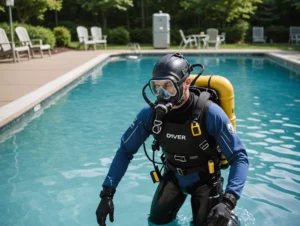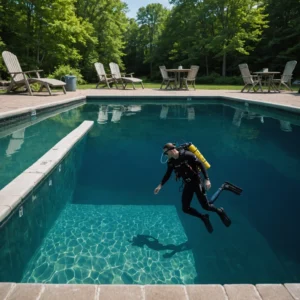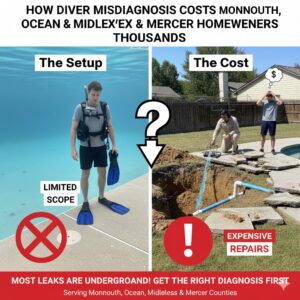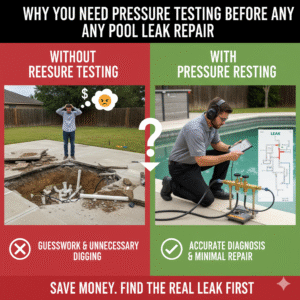Homeowners throughout Monmouth County often assume that hiring a pool diver is the fastest and most accurate way to find a pool leak. After all, divers appear confident, experienced, and ready to jump in the water with minimal preparation. However, this approach leads to repeated misdiagnosis, wasted money, and expensive digging that could have been completely avoided. Diver-only leak detection is fundamentally flawed because it focuses on the interior of the pool while ignoring the underground plumbing system, which causes more than half of all residential leaks in New Jersey. Without pressure testing, electronic locating, and line isolation, divers simply cannot determine where water is escaping — and as a result, homeowners are frequently told their liner is torn or their steps are leaking, even when neither of those things are true.
In Monmouth County communities like Freehold, Marlboro, Manalapan, Colts Neck, and Holmdel, pool systems experience a wide range of conditions that divers are not equipped to diagnose. Soil movement, aging plumbing, winter freeze cycles, and deck expansion all contribute to underground pipe cracks that divers cannot see from inside the pool. A diver may swim to the wall and say they “hear” something or “feel” an area of concern, but this is guesswork disguised as expertise. Real leak detection requires scientific measurement — not opinions formed underwater. Homeowners deserve a clear, data-backed answer, not a best guess.
A properly performed leak inspection begins with isolating each pipe individually. Technicians attach precision gauges to suction and return lines, plug the system, and apply air pressure. If a line does not hold pressure, it is leaking somewhere underground — something a diver could never determine by swimming. Once the failing line is identified, acoustic listening equipment is used to track the exact location of escaping air or water beneath patios, decks, soil, or concrete. This pinpoint method prevents unnecessary digging and saves homeowners from tearing apart sections of the yard that are not leaking. Without these tools, divers simply cannot provide an accurate diagnosis.
In addition to underground plumbing leaks, structural issues around skimmers, wall penetrations, and return fittings require specialized testing that divers are not trained to perform. For example, a diver may incorrectly conclude that a skimmer throat is cracked because they see a small line or imperfection underwater. However, many skimmer leaks come from behind the skimmer where the plumbing meets the body — an area completely invisible to divers. Similarly, return jets may appear intact underwater, but they may be leaking behind the wall or deep within the line. Only static testing, dye tests performed under controlled conditions, and pressure isolation can determine the truth.
Monmouth County homeowners often discover the financial consequences of diver-only testing the hard way. After the diver leaves, the pool continues to lose water. Homeowners call them back, only to receive a different guess, a different opinion, or another patch that fails within days. By the time the real leak is found, hundreds or even thousands of gallons of water have been wasted. In towns like Red Bank, Middletown, Aberdeen, and Long Branch, repeated refilling during the summer can add hundreds of dollars to water bills. Worse, unnecessary liner replacements — often recommended by divers who cannot identify plumbing leaks — can cost more than $4,000.
The most troubling part is the false sense of confidence divers project. Because the homeowner sees someone physically inspect the pool, they assume a thorough diagnostic was done. But without pressure testing equipment, locator tools, sonic listening devices, and line-isolation plugs, divers are only inspecting 40–50% of the pool system. No mechanic would diagnose a car engine by looking only at the tires, and no HVAC professional would diagnose a system by checking only the thermostat. Yet divers often claim certainty based on underwater observation alone.
Real leak detection involves a systematic, measurable, replicable process. Every line is isolated, every structure is tested, and every reading is documented. This is how professional technicians identify cracks behind skimmers, broken return lines under patios, step leaks, main drain leaks, and underground pipe separations. These are issues divers cannot diagnose because they occur outside the diver’s field of view. Monmouth County pools often have complex plumbing layouts due to large backyards and long equipment runs, which make scientific testing even more critical.
When comparing diver-only services to real leak detection companies, the difference becomes obvious. Divers rely on visual opinion. Real technicians rely on instrumentation. Divers look for symptoms. Real leak detection finds the cause. And most importantly, real leak detection gives homeowners a precise repair plan rather than guess-based recommendations. With the number of underground leaks increasing in Monmouth County due to aging infrastructure and harsh winter conditions, choosing the right method is more important than ever.
Homeowners deserve accurate diagnostics, transparent findings, and dependable solutions. By avoiding diver-only leak detection and choosing real, science-based testing, Monmouth County residents can stop wasting money, prevent unnecessary repairs, and protect their property from further damage. A true leak detection specialist will always provide measurable results — not guesses made at the bottom of a pool.







